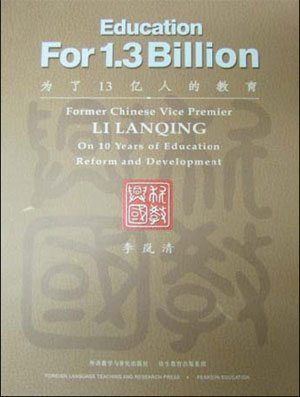The education of a nation
Updated: 2012-12-07 09:12
By Chris Husbands (China Daily)
|
|||||||||||
|
Former Chinese vice-premier Li Lanqing gives his account of how the country came to realize the importance of education. Peng Nian / for China Daily |

How china transformed the way in which its people learn
The 19th century economy was powered by coal. The 20th century economy was powered by oil. The 21st century economy will be driven by education. Across the world, the individual economic returns from an additional year of schooling average at 8 percent. The advice we should give to any young person, to any family, to any country is clear: Invest in education, invest in early education, sustain investment in education and, above all, invest in the quality of education.
The difference between the winners and the losers in the 21st century will be the difference between levels of investment in education. This is already clear. The "tiger economies" of the Pacific rim have demonstrated that long-term sustained economic growth is sustained by, and itself sustains, significant development of high-quality educational infrastructures, not only for social elites but for all children and young people. A coherent national plan for education appears to be an essential accompaniment to a thriving, technologically advanced economy.
Education for 1.3 Billion is Li Lanqing's account of China's realization of the importance of education. Li was vice-premier of the State Council from 1993 to 2003, a period in which Chinese education was substantially transformed. The title alone is a daunting reminder of the sheer scale of the task facing education reform in China. No other country faced, or faces, challenges on such an enormous scale.
Five themes dominate the book: the challenge of bringing education to rural China at scale; the challenge of securing high-quality education; the challenge of improving science and technology teaching; the challenge of securing what Li calls "character education", or what in England and North America would be called civics, citizenship or social education; and the challenge of higher-education reform.
One of Li's most important insights is that while the basics of education were (and remain) very important, they cannot be separated from the wider challenge of general, social education. His own role in the transformation of Chinese education is described, early on, and again later, as that of a "quartermaster" - understanding logistics, organizing resources, asking hard questions of experts and challenging them to go further and faster.
The five themes that underpin Li's account obviously interact with each other. The fundamental challenge of ensuring that basic education is in place is grounded in the importance of securing participation across China and the drive to eliminate illiteracy across primary schools. But equally critical to improving basic education was the importance of improving teaching; of making, as Li puts it, "teaching an enviable profession". The two priorities are inseparable, but the key challenge of getting enough teachers of the right quality into the right schools is a challenge that has bedeviled education reform worldwide.
In the 21st century, basic education cannot be separated from science and technology education, an insight Li realized very quickly. Universities are important too, in terms of providing hubs for regional economic and social development, and as the pinnacles of the education system. China's challenge in Project 211 was to develop "top-notch" rather than "look-alike" universities, giving universities freedom to explore and develop knowledge. But one of the most absorbing chapters of the book (pages 301-397) explores the development of character education, a range of knowledge that cultivates "students' innovative spirit and practical skills" through a range of large-scale projects.
The drive for education success in China was system wide. The sheer logistics of the challenge are mind-boggling: In 2002 there were more than 310 million children and young people in schools and colleges at all levels - more than the entire population of the United States - and there are 1,075 institutions of higher learning, more universities than in the whole of the European Union.
Two key developments underpinned the development of large-scale provision of education, namely increased investment and a legal framework within which education could be constructed - there were something like 200 central regulations and more than 150 local laws. Again, this is an enormous undertaking. The descriptions in this book speak of Li's gradual transition from "responsibility" to "devotion".
It is important to set Li's account in the wider context of what we know about education-system reform across the world. Some common themes occur. Nothing in education is more important than the quality of teachers and teaching, and Li was right to link the development of basic education to the development of the teaching profession.
We have learned, from places as far apart as Singapore, Finland and Ontario, that the quality of the teaching profession -or, more important, the quality of teaching - drives educational reform. Improving the quality of teachers matters on so many levels. The better the quality of teaching, the better the quality of what children experience, the stronger the role models they have and the more likely it is that they will become teachers themselves.
The importance of basic education cannot be underestimated. Again, a core preoccupation of worldwide education reform has been the drive to bring all learners up to levels of functional literacy that enable them to function as independent workers in complex workplaces. It is no longer enough to educate the elite.
What is remarkable about Li's account is his drive to take this to scale. Universities matter too, and the conviction expressed early on that "look-alike" universities are poor models for serious economic and social development echoes a world-wide recognition - from Silicon Valley in California to the Cambridge region in England to the Institutes of Technology in Bangalore - that robust, independent universities with the incentive to develop and diversify can be powerful drivers of economic regeneration and the knowledge economy.
In these ways, one of the powerful lessons from Education for 1.3 Billion is that the worldwide lessons of education reform in small countries also apply in a large country. This makes the book an important contribution to our knowledge base about education transformation. The achievement in China was remarkable. By the end of the 20th century, nine-year compulsory education was nearly universal and illiteracy practically wiped out among the young and the middle-aged, while secondary education had increased enormously. By 2002, there were 16 million students in different types of higher education institutions, with 9.03 million attending regular colleges and universities.
Of course, education reform is never complete. By 2004, China had committed to spending 4 percent of its GDP on education. But South Korea and Finland were spending 6 percent and the UK more than 5 percent. The worldwide race for education transformation continues.
As its education system matures, China faces many of the challenges of education systems across the world: the importance of eradicating education attainment gaps between the urban elite and the rural poor, the importance of building higher-level skills, the importance of preparing young people for a world of resource depletion and environmental challenge. Li's own account recognizes that the challenges are changing: The Internet, for example, did not exist when he assumed responsibility for education, but he is aware of its potential to transform schooling in remote rural areas. But this is an account of a remarkable transformation, and it concludes with Li's appreciation that what is needed is a "learning-based society". No education system in the world has transformed itself as quickly or completely as the Chinese education system. That achievement is Li's, and his book is as remarkable as the achievement.
The author is director of the Institute of Education, University of London.
For China Daily
(China Daily 12/07/2012 page30)
Today's Top News
Rescuers race against time for quake victims
Telecom workers restore links
Coal mine blast kills 18 in Jilin
Intl scholarship puts China on the map
More bird flu patients discharged
Gold loses sheen, but still a safe bet
US 'turns blind eye to human rights'
Telecom workers restore links
Hot Topics
Lunar probe , China growth forecasts, Emission rules get tougher, China seen through 'colored lens', International board,
Editor's Picks

|

|

|

|

|

|






